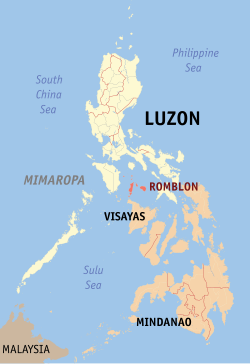| Romblon's at-large congressional district | |
|---|---|
| Constituency for the House of Representatives of the Philippines | |
 Location of Romblon within the Philippines | |
| Province | Romblon |
| Region | Mimaropa |
| Population | 308,985 (2020) [1] |
| Electorate | 206,119 (2022) [2] |
| Area | 1,533.45 km2 (592.07 sq mi) |
| Current constituency | |
| Created | 1919 (single-member district) |
| Representative | Eleandro Jesus F. Madrona |
| Political party | Nacionalista |
| Congressional bloc | Majority |
Romblon's at-large congressional district refers to the lone congressional district of the Philippines in the province of Romblon. It has been represented in the House of Representatives of the Philippines since 1919 and earlier in the Malolos Congress (National Assembly) of the First Philippine Republic from 1898 to 1901. [3] [4] Romblon has been represented by a single representative elected provincewide at-large since its reestablishment as a regular province separate from Capiz in 1917. [5] From 1943 to 1944, the district was again dissolved and reconsolidated with Capiz for the National Assembly of the Second Philippine Republic. Between 1978 and 1984, regional delegations were formed in lieu of provinces for the national parliament of the Fourth Philippine Republic, with Romblon forming part of the twenty-seat Region IV-A's at-large district. [6] It was restored as a single-member district in 1984. [3]
Contents
- Representation history
- Romblon's at-large district for the Malolos Congress
- Romblon's at-large district for the House of Representatives of the Philippine Islands
- Romblon's at-large district for the National Assembly (Commonwealth of the Philippines)
- Romblon's at-large district for the House of Representatives of the Commonwealth of the Philippines
- Romblon's at-large district for the House of Representatives of the Philippines
- Romblon's at-large district for the Regular Batasang Pambansa
- Romblon's at-large district for the House of Representatives of the Philippines 2
- Election results
- 2025
- 2016
- 2013
- 2010
- See also
- References
The district is currently represented in the 20th Congress by Eleandro Jesus F. Madrona of the Nacionalista Party (NP). [7]






